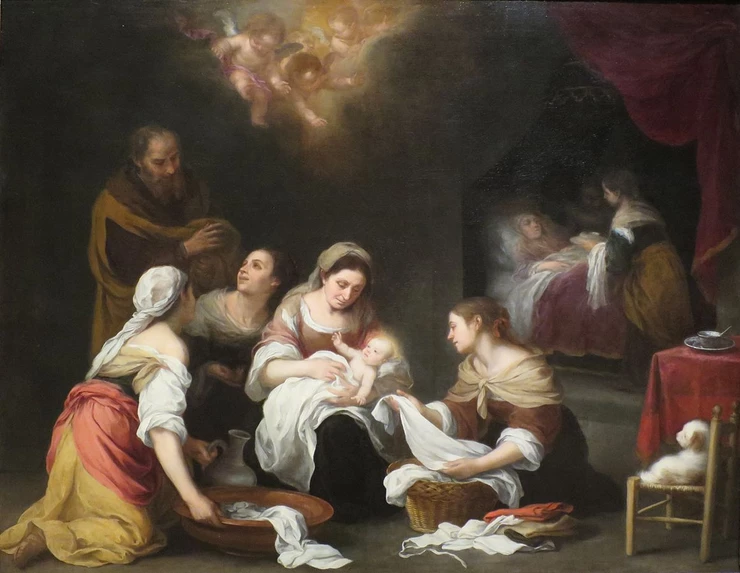Bartolomé-Esteban Murillo - The Birth of John the Baptist
- Alexandra Tuschka
- 9. Apr. 2022
- 3 Min. Lesezeit
by Alexandra Tuschka
In a sparsely furnished interior we witness an intimate scene. The newborn in the centre of the picture is being wrapped in white cloths and dried by the wet nurses. The new mother lies exhausted in bed in the background. The father, a man with thinning hair, stands to the left of the picture and looks at the child. Not only the bright nimbus marks this as holy, but also the angels, who obviously want to take a look at the child and offer another source of light, underline its divine origin. A little dog on the right of the chair is lazy, but at least lifts its head and looks over.

The scene depicted here refers to the Gospel of Luke 1:5 - 25, where it is described that an angel appears to the aged priest Zacharias, who prophesies a child, a boy, to him and his - equally aged - wife Elizabeth. They are to name him "John" (Hebrew: "God is gracious"). This refers to the birth of John the Baptist. So far, both have remained childless. Zechariah cannot believe this and asks for a sign. The angel silences him. After the child is born, Elizabeth wants to give him the name "John", although she could not learn of this name from her husband.
Of course, we do not see the birth of the child here, but its first bath. Although this scene is not mentioned in the source text, it is still an important and in many cultures ritual act shortly after birth. In this case, the child was lifted out of the large copper bowl onto the lap of a wet nurse. Three others accompany the washing with many white cloths. The colour white may represent the purity of the protagonist. The whole pictorial theme of the bath also refers symbolically to the boy's later role as a baptiser. In contrast, the heavily used red can be understood as a martyr's colour, which points to John's death.
The birth of John the Baptist is not only given a special significance in the Bible, for the Gospel of Luke begins with it; but it is also one of the three birthdays that have found a place in the biblical calendar at all. In this case, devout Christians celebrate John's birthday on 24 June. Only Mary and Jesus are otherwise accorded this honour.

Murillo manages to place the sacred theme in an everyday scene. Not only do the wet nurses have a peasant's appearance, the exhaustion of Mother Elizabeth in particular gives an all too lifelike impression. At the time of its creation around 1660, the painter's hometown, Seville, had been struck by numerous misfortunes. The choice of this pictorial subject may have been associated with a glimmer of hope and probably ended up in one of the many churches or convents in the area.
In the comparative work by Artemisia Gentileschi, we see a similarly realistic scene, with several wet nurses lovingly caring for the newborn. In this case, further references to show the sanctity of the scene have been omitted. The pictorial theme, however, becomes additionally clear through the small intermediate scene on the left. Here Zacharias, who at this point is not yet able to speak again, writes that he agrees with the name "John" for his child on a small tablet. With this gesture he finally regains his speech.
Bartolomé-Esteban Murillo - The Birth of John the Baptist
Oil on canvas, ca. 1655, 145 x 185 cm, Norton Simon Museum, USA
Artemisia Gentileschi - The Birth of John the Baptist
Oil on canvas, 1634, 184 cm × 258 cm, Museo del Prado, Madrid






